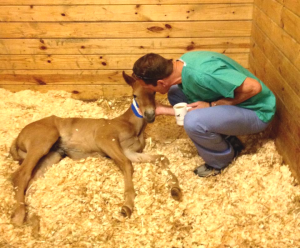From New England Equine Medical & Surgical
by: By Dr. Ella Pittman, DVM

Introduction
Umbilical infections, also called
omphalitis or omphalophlebitis, and are an
inflammation of any one of the structures
that make up a foal’s belly button. The
umbilicus consists of two arteries, a vein,
and the urachus. The umbilical arteries
carry deoxygenated blood away from the
fetus and returns the blood to the placenta.
The umbilical arteries give rise to the
round ligaments of the bladder in the adult.
The umbilical vein brings oxygenated
and nutrient-rich blood to the fetus from
the maternal circulation. In the adult the
umbilical vein becomes the round ligament
of the liver. The urachus is a remnant of the
canal that drains the fetus’ bladder

Pathogenesis
At birth, the umbilicus breaks, leaving
behind a small external remnant and a large
internal remnant. Bacteria can invade the
large internal remnant through the external
remnant, leading to localized infection
of one or more of the aforementioned
umbilical structures. The bacteria can
then get into the bloodstream and cause
infection at other sites including the lungs,
gastrointestinal tract and joints. When this
happens, the foal becomes septic and is very
sick.
Clinical Signs
Clinical signs vary, depending on
whether the foal is septic. Generalized nonspecific
signs include fever, inappetance,
depression, or lethargy. Signs specific
to infection of the umbilicus (with or
without sepsis) include umbilical swelling,
purulent discharge, heat and pain. In foals
with primary sepsis or sepsis secondary to
an infected umbilicus, clinical signs can
affect other organ systems. These include
difficulty breathing, rapid breathing,
diarrhea, colic, swollen joints, lameness,
Diagnosis
Diagnosis can be made by physical
exam and palpation of the umbilicus but
not always. External signs (heat, pain,
swelling, purulent discharge) may or may
not be present. In some cases, an infected
umbilicus is only suspected because the foal
has a fever without another obvious cause
or has a swollen joint. Serum amyloid A and
fibrinogen, two markers of inflammation in
the blood, are usually elevated. The gold
standard for diagnosis is enlargement of
one or more of the structures on ultrasound.
Hyperechogenic material (pus) can often be
appreciated as well.
Treatment
Options for treatment include
medical management and surgery. Broad
spectrum antibiotics should be initiated
with either course of treatment. Candidates
for medical management are those with
localized infection (ie not septic) and those
who are not anesthetic/surgical candidates
due to other medical conditions. Recheck
ultrasound of the affected umbilical
structures should be performed every five
to seven days to ensure that the treatment
is working. If the foal is not responsive
to medical therapy, has a large lesion and/
or has multiple structures affected, or has
multiple affected organ systems, surgery to
remove the infected structures provides the
best long-term prognosis.
Prevention
First line of defense in protecting
a foal from any disease, including umbilical
infections and sepsis, is to ensure adequate
colostrum update. Foals should nurse
within 2 hours of birth. The first milk they
receive from mom is called colostrum,
which is rich in immunoglobulins - the
soldiers of our immune system. Colostrum
is specifically high in an antibody called
IgG. At birth, the foal’s gastrointestinal
tract is “open,” meaning that the foal can
absorb mom’s immunoglobulins. Greatest
absorption occurs within the first 6 hours
and then declines until the gastrointestinal
tract closes at 24 hours. This entire process
is called passive transfer of immunity. It is
important to check a foal’s IgG level at about
12 hours following birth to ensure the foal
has received adequate immunoglobulins.
Adequate levels are >800. Foals with levels
below 400 should receive plasma before
their gastrointestinal tract closes.
The umbilicus should also be
dipped several times after birth in order
to encourage the umbilicus to “dry” and
close. Current recommended dipping
agents include dilute chlorhexidine or
iodine solutions. Ensure the chlorhexidine
or iodine is a solution not a scrub. Using
agents that are too caustic or dipping too
much can cause scalding of the ventral
abdomen and may promote patency of the
urachus.
Source: Reed et al. Equine Internal
Medicine. 2010.

